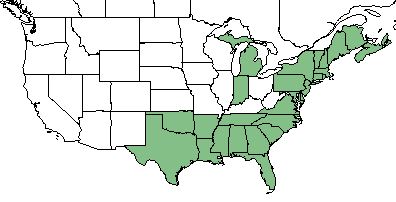Difference between revisions of "Utricularia radiata"
(→Distribution) |
|||
| Line 25: | Line 25: | ||
<!-- Basic life history facts such as annual/perrenial, monoecious/dioecious, root morphology, seed type, etc. --> | <!-- Basic life history facts such as annual/perrenial, monoecious/dioecious, root morphology, seed type, etc. --> | ||
==Distribution== | ==Distribution== | ||
| + | This species occurs from Nova Scotia, New Brunswick, and Maine, southward to southern Florida, westward to Texas, and disjunct in western Virginia, western Tennessee, and northwestern Indiana. Reports of it occurring in Cuba and South America are in error according to Weakley.<ref name="Weakley 2015"/> | ||
| + | |||
==Ecology== | ==Ecology== | ||
===Habitat=== <!--Natural communities, human disturbed habitats, topography, hydrology, soils, light, fire regime requirements for removal of competition, etc.--> | ===Habitat=== <!--Natural communities, human disturbed habitats, topography, hydrology, soils, light, fire regime requirements for removal of competition, etc.--> | ||
Revision as of 16:06, 15 February 2018
| Utricularia radiata | |
|---|---|

| |
| Photo by Fred Nation hosted at Atlas of Florida Plants | |
| Scientific classification | |
| Kingdom: | Plantae |
| Division: | Magnoliophyta - Flowering plants |
| Class: | Magnoliopsida - Dicots |
| Order: | Scrophulariales |
| Family: | Lentibulariaceae |
| Genus: | Utricularia |
| Species: | U. radiata |
| Binomial name | |
| Utricularia radiata Small | |

| |
| Natural range of Utricularia radiata from USDA NRCS Plants Database. | |
Common Names: floating bladderwort; small swollen bladderwort;[1] little floating bladderwort[2]
Contents
Taxonomic Notes
Synonym: U. inflata var. minor[1]
Description
Distribution
This species occurs from Nova Scotia, New Brunswick, and Maine, southward to southern Florida, westward to Texas, and disjunct in western Virginia, western Tennessee, and northwestern Indiana. Reports of it occurring in Cuba and South America are in error according to Weakley.[1]
Ecology
Habitat
U. radiata occurs in ponds, depression ponds, lakes, and ditches.[1]
Phenology
In the southeastern and mid-Atlantic United States, U. radiata flowers from may through November.[1]